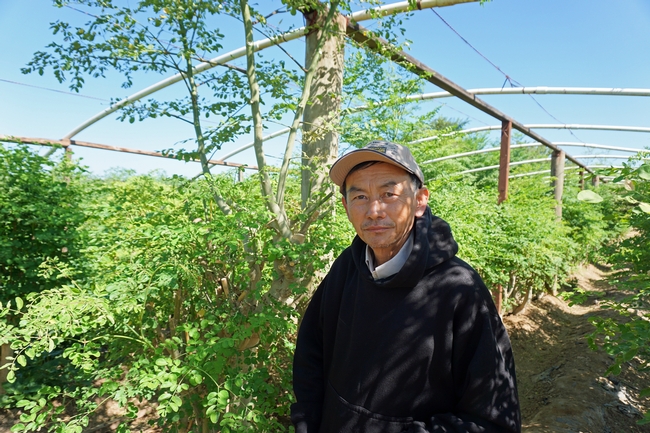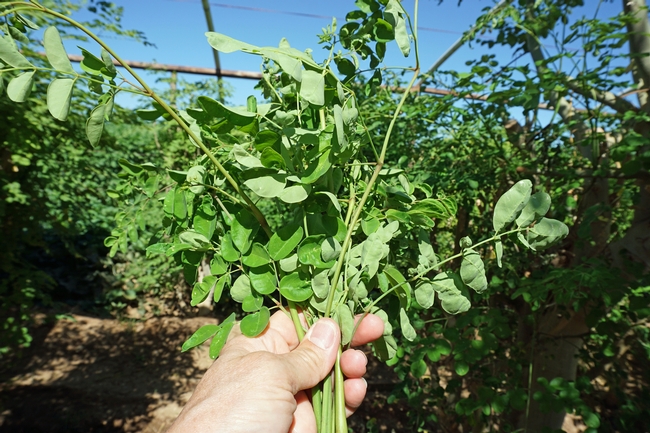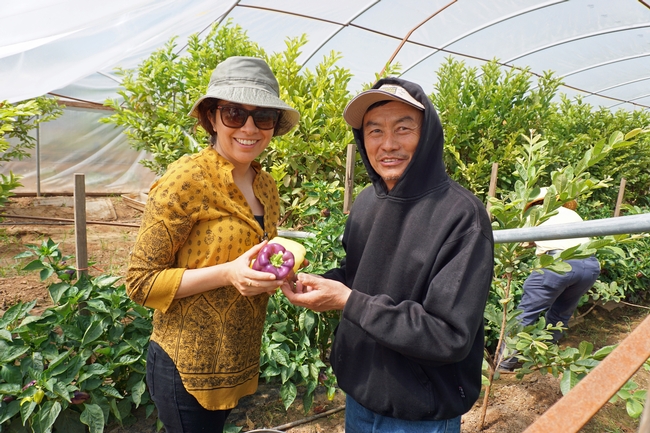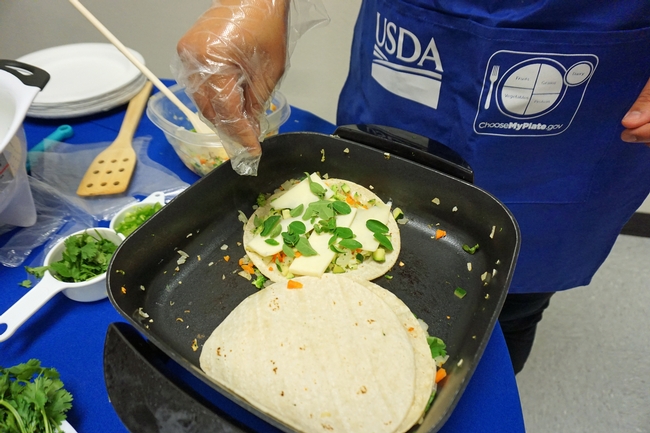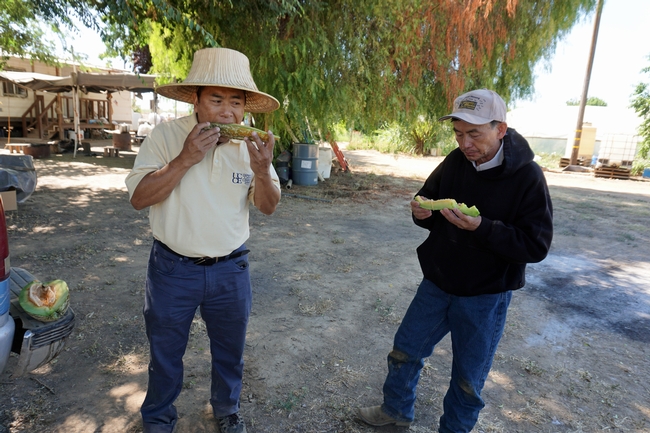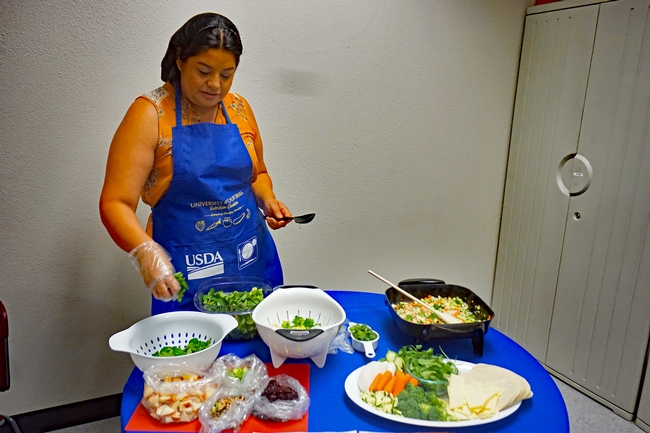Farmer Vang Thao has been managing a successful farm south of Fresno for nearly 30 years, producing a spectacular array of vegetables – heirloom tomatoes, purple bell peppers, water spinach, bitter melon, Thai eggplant and dozens of others.
Every weekend the family traverses the Grape Vine to set up a visual feast at farmers markets in Santa Monica, Hollywood, Palos Verdes, Torrance and Hollywood. Acclaimed Los Angeles chefs rave about his produce, according to a Los Angeles Times feature story on the Thao family.
Produce like sweet potato leaves, amaranth and black nightshade are essential for families hailing from Vietnam, Laos, Thailand, the Philippines and India who seek ingredients for their traditional cuisine, but the market is limited. Now, small-scale farmers like the Thaos are on the cusp of something with much wider appeal.
One of their crops is moringa, a tropical tree that produces an abundance of fresh shoots to sell at the farmers market booth for $1 a bundle. Moringa is a delicate green that can be added to salads, soups and nearly any other dish. It has a pleasant nutty, earthy and slightly pungent green flavor. While it tastes good, it's the plant's nutrient profile that is commanding attention.
On the internet, moringas are called miracle trees. All parts of the plant are edible – the tender leaves can be cooked or eaten fresh, moringa flowers are considered a delicacy, the tree's young pods can be used like green beans, roasted seeds are said to have antibiotic and antifungal properties. The roots and bark have medicinal potential, but need more study to determine the right dose. A 100 gram serving of moringa greens has more protein than a cup of milk, more iron than a cup of spinach, and is high in calcium, potassium, vitamin C and vitamin A.
Moringa is the Superfood of 2018, according to the trend watchers at SPINS.com. UC Davis nutrition researcher Carrie Waterman is studying moringa's use, production and processing worldwide. She is pursuing moringa for therapeutic applications in treating cancer, HIV and inflammatory bowel disease.
Ruth Dahlquist-Willard, the UC Cooperative Extension advisor to small-scale farmers in Fresno and Tulare counties, recognized moringa's potential to supplement income for Southeast Asian farming families who are marketing specialty Asian vegetables and herbs to immigrant communities.
“Moringa is a drought tolerant tree known for its excellent nutritional content,” Dahlquist-Willard said. “We believe it could improve the economic viability of small-scale farms in our community. We are helping small-scale farmers with moringa product development and marketing.”
Supporting farmers growing moringa in marketing the product to new buyers is an objective of the UCCE moringa project, a partnership with the UC Sustainable Agriculture Research and Education Program, which was funded by a California Department of Food and Agriculture specialty crop block grant. Lorena Ramos, the project lead, is working on developing marketing materials, outreach opportunities, and value-added options.
While using moringa is second nature for many immigrant groups, expanding the market includes demonstrating how easily the green can be used in the kitchen. Dahlquist-Willard and Ramos called on another sector of UC Cooperative Extension – the UC CalFresh Nutrition Education Program – for assistance. UCCE offers nutrition education in schools and community settings to children and families eligible for the USDA's nutrition assistance programs. Each year, Fresno State dietetic students serve two-week internships at UCCE. In 2018, one of their tasks was developing creative, healthful recipes incorporating moringa. Among the recipes were overnight oatmeal, pesto, smoothies, guacamole and energy bites – all with moringa.
“We are publishing the best recipes to share with the public to help them add this nutritional green into their diets,” Ramos said.
Recipe cards and moringa samples will be available July 26 at the Fresno Food Expo, where UCCE is hosting a booth to raise awareness about moringa by introducing farmers to Fresno area chefs, buyers and consumers and sharing information about the vegetable's health benefits, culinary versatility and its ability support small-scale farmers in Fresno and Tulare counties.
Following is a USDA recipe ideal for incorporating moringa:
Grilled quesadilla with vegetables
Ingredients
Nonstick cooking spray
1 medium zucchini, diced
½ broccoli head, diced
1 green pepper, diced
1 medium onion, minced
1 carrot, peeled and grated
16 (6 inch) flour tortillas
12 ounces cheese, shredded
½ cup moringa leaves
Directions
- Wash all vegetables.
- Collect, dice, shred and measure all ingredients before starting to prepare the recipe.
- Spray a large skillet with cooking spray. Add zucchini, broccoli, green pepper, onion and carrot. Cook vegetables on medium heat for 4 to 5 minutes, stirring frequently. Remove vegetables from skillet, and put on a clean plate.
- Spray skillet with cooking spray again and place 1 tortilla in the skillet. Top with ½ cup vegetables and 1/3 cup cheese. Sprinkle on fresh moringa leaves.
- Place a second tortilla on top. Cook on medium low heat for 2 to 3 minutes or until the cheese starts to melt and the bottom tortilla starts to brown.
- Flip over the quesadilla. Cook for another 2 to 3 minutes until tortilla brons.
- Repeat steps 4 through 6 to make additional quesadillas
- Cut each quesadilla in half or quarters, serve hot with your favorite salsa or other toppings.
- Refrigerate leftovers within 2 hours. Eat within 3 to 5 days.
